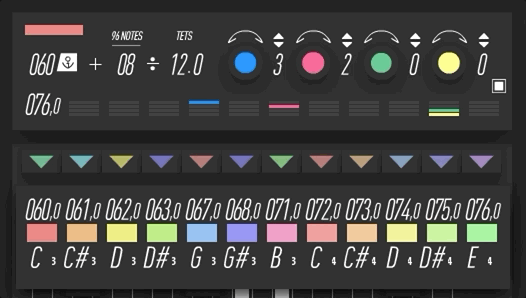TUNING SYSTEMS
COLLIDZ° offers a new paradigm for creating melodies and harmonic scores, through playing and programming from a selection of 12 notes or 12 frequencies.
The concept may seem restrictive, but it encourages here to explore new horizons of melodic research. Although minimal, it is possible to interpret its 12 notes in an entirely polyphonic way.
COLLIDZ°'s custom or forced tuning principle makes it possible to anticipate a suite of notes configurations often explored on stringed instruments such as guitars (when for instance the strings are played open). It is more directly inspired by the lamella principle, which can be found on a kalimba.
But here, it is a question of exploiting this principle of free tuning on the basis of synthetic tonalities (offered by the 4 modules presented in the previous chapter). It also allows you to create your own microtonal scales.
NOTE: The launching/triggering of these 12 notes is accessible in MIDI from any type of MIDI keyboard or controller via these 12 Note controls: C3, D3, E3, F3, G3, A3, B3, C4, D4, E4, F4, G4
The configuration of these 12 notes is made possible by 3 different tuning modules, specialized according to whether one seeks to apply :



We will see now how to use them in details.
But first, see as the activation/deactivation of the 3 modules follows a hierarchy:

The extended tuning fork/anchor button allows you to switch between CUSTOM mode and ANCHOR mode.
The multi-bar button engages FORCE mode, which overrides the pre-selected default mode.
FORCE - Scales, Modes & Chords filter.
Kind of "easy" mode, FORCE module allows you to apply a scale, a mode, or a specific chord to the 12 notes of the instrument.

On the left, the MAIN ROOT NOTE knob sets the global system root note. The default value is set to C3, but it can be set to any note you like, in the ranges 1-5.
The SEND TO button sends the pre-selected scale, mode, or chords configuration to the CUSTOM tuning module. It facilitates the creation of original tunings starting from a classic basis. Notes: This command does not send Root Note information.
CUSTOM - Tuning module.
This mode allows defining a specific note or frequency for each of the 12 COLLIDZ° notes.
Press/trigger any of the C3, D3, E3, F3, G3, A3, B3, C4, D4, E4, F4, G4 MIDI notes in order to display their related settings :

NOTE NAME & MIDI NOTE NUMBER defines the midi note (in the range of 128 MIDI notes available).
FREQUENCY sets the coarse/pitch of the corresponding note slot. This command is split into two. Compared to the digital display of this value, the frequency is adjusted by pointing to the cursor before the decimal point, and it is possible to refine the settings by pointing to the cursor after the decimal point.
OCTAVE sets which octave is selected. When this parameter is changed, it overrides the NOTE NAME/MIDI NOTE NUMBER settings.
The VIRTUAL KEYBOARDS allows setting the note directly by clicking and choosing a position on the virtual piano keyboards.
ANCHOR - Scale calculator (expert mode).
The last module is an advanced calculator system that allows defining a factor of the division of the whole frequency range, in order to obtain an unusual configuration of tuning and scales.
It is also possible to refine these alternative tunings from 4 specific commands, called "anchors", which allow jumping by one or more tets (1 to 4) on the tuning range obtained.
Follow these steps :




